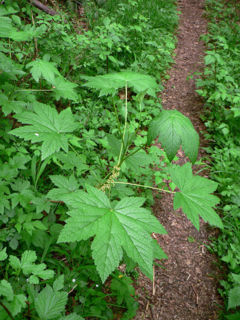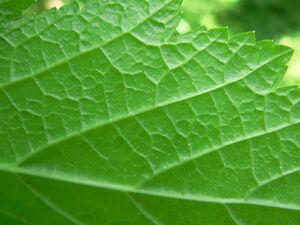Ribes bracteosum
| subsp. var. | ||||||||||||||||||||||||||||||||||||||||||||||||||||||||
|---|---|---|---|---|---|---|---|---|---|---|---|---|---|---|---|---|---|---|---|---|---|---|---|---|---|---|---|---|---|---|---|---|---|---|---|---|---|---|---|---|---|---|---|---|---|---|---|---|---|---|---|---|---|---|---|---|

|
|
| ||||||||||||||||||||||||||||||||||||||||||||||||||||||
| ||||||||||||||||||||||||||||||||||||||||||||||||||||||||
| Standard Cyclopedia of Horticulture |
|---|
|
Ribes bracteosum, Douglas. Californian Black Currant. Shrub, to 8 ft., with upright or ascending sts.: young growth sparingly pubescent and resinous-dotted: lvs. thin, cordate, deeply 5-7-lobed, with ovate to ovate-lanceolate, acute, sharply serrate lobes, 2-8 in. broad: racemes narrow, slender, upright, often 8 in. long; bracts spatulate, half as long as the pedicels, the lower foliaceous; fls. greenish or purplish; calyx-tube cup-shaped; sepals spreading, ovate-oblong, 1/6in. long; petals minute, obtuse: fr. globose, black with whitish bloom, resinous-dotted, edible. Alaska to N. Calif. B.M. 7419.—Hardy at the Arnold Arboretum; remarkable for its large maple-like lvs. and the long bracted racemes. A hybrid of this species with R. nigrum is R. fuscescens, Jancz. (R. bracteosum var. fuscescens, Jancz.); it differs chiefly in its reddish brown fls., in the small linear bracts of the spreading or arching infl., and in the larger fr. Gt. 55, p. 162. Originated in Scotland.
|
| Ribes bracteosum {{{status}}} Fossil range: {{{fossil_range}}}
| ||||||||||||||||||||||||||||||||||||||||||||||||||||||||||||||||||
|---|---|---|---|---|---|---|---|---|---|---|---|---|---|---|---|---|---|---|---|---|---|---|---|---|---|---|---|---|---|---|---|---|---|---|---|---|---|---|---|---|---|---|---|---|---|---|---|---|---|---|---|---|---|---|---|---|---|---|---|---|---|---|---|---|---|---|
 | ||||||||||||||||||||||||||||||||||||||||||||||||||||||||||||||||||
| Plant Info | ||||||||||||||||||||||||||||||||||||||||||||||||||||||||||||||||||
| ||||||||||||||||||||||||||||||||||||||||||||||||||||||||||||||||||
| Scientific classification | ||||||||||||||||||||||||||||||||||||||||||||||||||||||||||||||||||
| ||||||||||||||||||||||||||||||||||||||||||||||||||||||||||||||||||
| [[{{{diversity_link}}}|Diversity]] | ||||||||||||||||||||||||||||||||||||||||||||||||||||||||||||||||||
| {{{diversity}}} | ||||||||||||||||||||||||||||||||||||||||||||||||||||||||||||||||||
| Binomial name | ||||||||||||||||||||||||||||||||||||||||||||||||||||||||||||||||||
| Ribes bracteosum Dougl. ex Hook. | ||||||||||||||||||||||||||||||||||||||||||||||||||||||||||||||||||
| Trinomial name | ||||||||||||||||||||||||||||||||||||||||||||||||||||||||||||||||||
| {{{trinomial}}} | ||||||||||||||||||||||||||||||||||||||||||||||||||||||||||||||||||
| Type Species | ||||||||||||||||||||||||||||||||||||||||||||||||||||||||||||||||||
| {{{type_species}}} | ||||||||||||||||||||||||||||||||||||||||||||||||||||||||||||||||||
| {{{subdivision_ranks}}} | ||||||||||||||||||||||||||||||||||||||||||||||||||||||||||||||||||
| [[Image:{{{range_map}}}|{{{range_map_width}}}|]] | ||||||||||||||||||||||||||||||||||||||||||||||||||||||||||||||||||
| Synonyms | ||||||||||||||||||||||||||||||||||||||||||||||||||||||||||||||||||
| {{{synonyms}}} |
Ribes bracteosum (Stink Currant is a species of currant native to western coastal North America.

It is a deciduous shrub, without thorns, growing to 3 m tall. The leaves are 5-20 cm broad, palmately lobed with five to seven lobes. The flowers are produced in spring after the leaves emerge, on racemes 15-30 cm long of 20-40 flowers; each flower is 5-10 mm diameter, with five white or greenish-tinged petals. The fruit, born in clusters, is dark blue with a whitish bloom, edible but sometimes unpleasant.